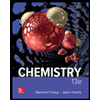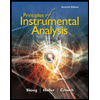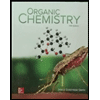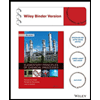
ORGANIC CHEMISTRY (LL) W/ACCESS
4th Edition
ISBN: 9781119856122
Author: Klein
Publisher: WILEY
expand_more
expand_more
format_list_bulleted
Question
Chapter 14, Problem 73IP
Interpretation Introduction
Interpretation:
The carbon-oxygen bond that produces higher energy signal in IR spectrum should be determined.
Concept Introduction:
IR spectral studies: It is a spectroscopic technique which is used to determine the
Wavenumber: It is defined as the number of waves in one centimeter. The wavenumber indicates the location of each signal with respect to the functional group in the molecule and its unit is
To explain: The carbon-oxygen bond that produces higher energy signal in IR spectrum.
Expert Solution & Answer
Want to see the full answer?
Check out a sample textbook solution
Students have asked these similar questions
Lewis structure of a generic amino acid labeling atoms, bonds and lone pairs
If multiple stereoisomers are formed, be sure to draw all products using appropriate wedges and dashes.
This question has two parts. Be sure to complete both parts before submitting your answer.
Draw the actual, correct product for this reaction.
CH3
Br
NaOMe
MeOH
CH₂
Δ
H₂C
CH3
Incorrect
H
Draw the structures of the precursors to 2-methylbutanenitrile given the reagents below.
PBr3
Structure
A
NaCN
Structure
B
H3C
CN
CH3
Chapter 14 Solutions
ORGANIC CHEMISTRY (LL) W/ACCESS
Ch. 14.3 - Prob. 1CCCh. 14.3 - Prob. 2CCCh. 14.3 - Prob. 3CCCh. 14.3 - Prob. 4CCCh. 14.4 - Prob. 5CCCh. 14.4 - Prob. 6CCCh. 14.4 - Prob. 7CCCh. 14.5 - Prob. 8CCCh. 14.5 - Prob. 9CCCh. 14.5 - Prob. 10CC
Ch. 14.5 - Prob. 11CCCh. 14.6 - Prob. 1LTSCh. 14.6 - Prob. 12PTSCh. 14.7 - Prob. 2LTSCh. 14.7 - Prob. 14PTSCh. 14.10 - Prob. 3LTSCh. 14.10 - Prob. 20PTSCh. 14.10 - Prob. 21ATSCh. 14.11 - Prob. 22CCCh. 14.11 - Prob. 23CCCh. 14.12 - Prob. 24CCCh. 14.12 - Prob. 25CCCh. 14.12 - Prob. 26CCCh. 14.12 - Prob. 27CCCh. 14.13 - Prob. 28CCCh. 14.13 - Prob. 29CCCh. 14.16 - Prob. 4LTSCh. 14 - Prob. 33PPCh. 14 - Prob. 34PPCh. 14 - Prob. 35PPCh. 14 - Prob. 36PPCh. 14 - Prob. 37PPCh. 14 - Prob. 38PPCh. 14 - Prob. 39PPCh. 14 - Prob. 40PPCh. 14 - Prob. 41PPCh. 14 - Prob. 42PPCh. 14 - Prob. 43PPCh. 14 - Prob. 67IPCh. 14 - Prob. 68IPCh. 14 - Prob. 69IPCh. 14 - Prob. 70IPCh. 14 - Prob. 71IPCh. 14 - Prob. 72IPCh. 14 - Prob. 73IPCh. 14 - Prob. 74IPCh. 14 - Prob. 75IP
Knowledge Booster
Similar questions
- 3-Methylaniline with NaNO2 in HCl at 0°C and subsequent reaction with water in an acidic medium.arrow_forwardThe reaction of cyclohexanone with diethylamine.arrow_forwardYou're preparing the 2-1 parenteral nutrition that uses potassium phosphate vials (3 mmol of phosphate and 4.4 meq of potassium per mL) to add the phosphate to the parenteral nutrtion. How many meq of potassium are added to the parenteral nutrition when the phosphate is added? Potassium 65 meq Phosphate 24 mmol Sterile water qs ad 2000mlarrow_forward
- The combined calcium and phosphorus in a parenteeral nutrition should not exceed 45 mEq/L. if the parenteral nutrition order shown containes 2mEq PO4/mmol, what is the combined calcium and phosphorus (mEq/L) in the parenteral nutrition order? Parenteral nutrition order: Potassium 65 mEq, Phosphate 24 mmol, Calcium 12 mEqarrow_forwardpls help on all asked.arrow_forward29. The following reaction takes place. A2B(s) = 2A (aq) + B(aq) + heat. If 2.50 moles of A2B is added into a 2.00 L container, it is found that 25.0% of the reactant dissociates to reach equilibrium. Find the solubility product constant, Ksp, for this reaction. Note: Your answer must include an ICE table.arrow_forward
arrow_back_ios
SEE MORE QUESTIONS
arrow_forward_ios
Recommended textbooks for you
 ChemistryChemistryISBN:9781305957404Author:Steven S. Zumdahl, Susan A. Zumdahl, Donald J. DeCostePublisher:Cengage Learning
ChemistryChemistryISBN:9781305957404Author:Steven S. Zumdahl, Susan A. Zumdahl, Donald J. DeCostePublisher:Cengage Learning ChemistryChemistryISBN:9781259911156Author:Raymond Chang Dr., Jason Overby ProfessorPublisher:McGraw-Hill Education
ChemistryChemistryISBN:9781259911156Author:Raymond Chang Dr., Jason Overby ProfessorPublisher:McGraw-Hill Education Principles of Instrumental AnalysisChemistryISBN:9781305577213Author:Douglas A. Skoog, F. James Holler, Stanley R. CrouchPublisher:Cengage Learning
Principles of Instrumental AnalysisChemistryISBN:9781305577213Author:Douglas A. Skoog, F. James Holler, Stanley R. CrouchPublisher:Cengage Learning Organic ChemistryChemistryISBN:9780078021558Author:Janice Gorzynski Smith Dr.Publisher:McGraw-Hill Education
Organic ChemistryChemistryISBN:9780078021558Author:Janice Gorzynski Smith Dr.Publisher:McGraw-Hill Education Chemistry: Principles and ReactionsChemistryISBN:9781305079373Author:William L. Masterton, Cecile N. HurleyPublisher:Cengage Learning
Chemistry: Principles and ReactionsChemistryISBN:9781305079373Author:William L. Masterton, Cecile N. HurleyPublisher:Cengage Learning Elementary Principles of Chemical Processes, Bind...ChemistryISBN:9781118431221Author:Richard M. Felder, Ronald W. Rousseau, Lisa G. BullardPublisher:WILEY
Elementary Principles of Chemical Processes, Bind...ChemistryISBN:9781118431221Author:Richard M. Felder, Ronald W. Rousseau, Lisa G. BullardPublisher:WILEY

Chemistry
Chemistry
ISBN:9781305957404
Author:Steven S. Zumdahl, Susan A. Zumdahl, Donald J. DeCoste
Publisher:Cengage Learning

Chemistry
Chemistry
ISBN:9781259911156
Author:Raymond Chang Dr., Jason Overby Professor
Publisher:McGraw-Hill Education

Principles of Instrumental Analysis
Chemistry
ISBN:9781305577213
Author:Douglas A. Skoog, F. James Holler, Stanley R. Crouch
Publisher:Cengage Learning

Organic Chemistry
Chemistry
ISBN:9780078021558
Author:Janice Gorzynski Smith Dr.
Publisher:McGraw-Hill Education

Chemistry: Principles and Reactions
Chemistry
ISBN:9781305079373
Author:William L. Masterton, Cecile N. Hurley
Publisher:Cengage Learning

Elementary Principles of Chemical Processes, Bind...
Chemistry
ISBN:9781118431221
Author:Richard M. Felder, Ronald W. Rousseau, Lisa G. Bullard
Publisher:WILEY